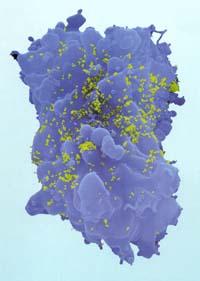Lucky mutants

HIV is a severe aggressor. It infects the defensive cells of the human body, the white blood cells, leaving the body without any defense. That is why it is so terrible that once the defenses are destroyed, the body is unprotected under any infectious agent.
However, one in ten Europeans suffer a mutation in a white blood cell protein called CCR5. If this protein is unconventional, the virus cannot enter the white blood cell, so it cannot infect the cell. It is clear that being mutant is an advantage over AIDS, right?
Researchers don't know why so many people have that mutation in Europe. And in the rest of the world the mutation is much rarer. According to scientists, one option might be that this mutation protects from another disease and that is why it has spread. That is, as in his day he protected from another disease, those who had the mutation managed to get ahead and their descendants too. This would help expand the mutation.
With this hypothesis, researchers wanted to know which disease was the key. They have seen that the mutation appeared some 2,500 years ago, long before the appearance of AIDS. And it seems that some epidemic of the Middle Ages contributed to expand the mutation, since since then the frequency of the mutation increases.

Researchers as detectives
According to British researchers in Liverpool, the mutation spread through the Black Plague or through it. The Black Death killed 40% of Europeans between 1347-1350, when one in twenty thousand people suffered mutation. That is, it was very rare. Subsequently, outbreaks of the disease occurred again and the last was the Great Plague of London in 1660. At that time the proportion of people with mutations increased considerably. It seems, therefore, that the mutation protected to some extent from the Black Plague, which allowed those who mutated it to prosper and their descendants. The mutation expanded.
Other London researchers do not match those of Liverpool. In his opinion, the Black Death had nothing to do with it, but the mutation became more common for smallpox. Baztanga was a very serious disease. Since the 20th century it caused many deaths. And above all, the cause of smallpox is a virus, while Black Plague is produced by a bacterium, Yersinia pestis. For London scientists it is more logical to think that it has spread because the mutation that protects from the AIDS virus protected it from another virus. And that virus can be more marginal.

But, according to supporters of the Black Death theory, smallpox was not an epidemic. Until the 20th century, and it does not seem to them that since then it has had time to expand the mutations. However, Londoners have the answer prepared and claim that, since smallpox mainly affects young children, the extent of the disease has not been taken into account until that century, which does not mean that it was not an epidemic before.
Arguments for and against
Those in Liverpool, however, do not give up and give other arguments. For example, the Black Death was transmitted by rats and they believe that this could influence. In addition, they have another hint in their favor: they are able to explain why the mutation is more frequent in northern Europe than in the south.

In fact, in Scandinavia and Russia 16% of the population suffers mutation, while in the south it is not so widespread, in Sardinia, for example, only 4% have mutation of white blood cell proteins. Why is there so much difference? According to researchers from Liverpool, in northern Europe the 19th. The apparitions of the Black Death occurred until the nineteenth century and the prolongation of the disease in time has made the mutation more frequent.
It is not a simple argument. However, it is impossible to know who is right. Perhaps over time they collect more vestiges and reinforce one of the two theories, or perhaps another is believed, who knows. But, at least, it is striking to know that a few centuries ago a disease that was really deadly helped some, one in ten of the Europeans, to be protected from another. Those mutants are congratulations!
Published in 7K.
Buletina
Bidali zure helbide elektronikoa eta jaso asteroko buletina zure sarrera-ontzian











